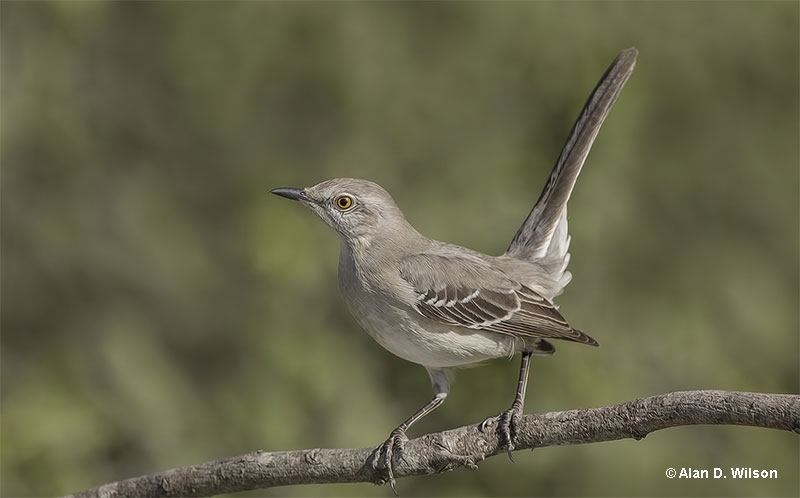
Florida is a southeastern U.S. state with the Atlantic on one side and the Gulf of Mexico on the other. It has hundreds of miles of beaches. The capital of the state is Tallahassee. It’s a large state with a population of 20.3 million people and a 65,755 square mile size. Florida’s state bird is the Northern Mockingbird.
This bird is a medium-sized bird with a long tail and is a bit slimmer than a thrush. Mockingbirds have long, thin bills, long legs, and small heads. Their wings are rounded, wide, and short. This is why the tail looks so long in flight.
Northern Mockingbirds are a grayish-brown color overall. The color gets player on the belly and the breast. Each wing has a white wingbar. A white patch can be seen on the outer tail feathers and each wing. The wing patches are easily visible when the birds are perched.
On this page
History
The Northern Mockingbird became the state bird of Florida on April 23, 1927. It was designated as Florida’s state bird by the Senate Concurrent Resolution No. 3 in a legislative session.
Northern Mockingbird was chosen as Florida’s state bird because it sings for the public. This little bird not only represents Florida well, but it also does its residents an excellent service. These birds consume insects known to be bothersome to the residents. Every bug it eats is one you don’t want in your lanai.
However, the Northern Mockingbird may not stay Florida’s State Bird. After almost 100 years, an effort is being made to replace this musical songbird with a bird that represents modern-day Florida.
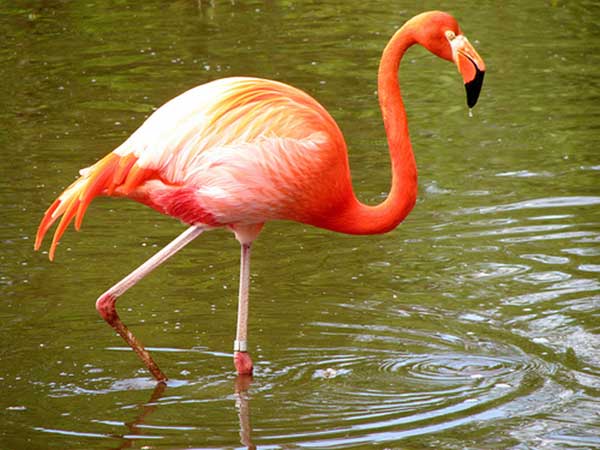
Flamingo might be the new Florida’s state bird
Sen. Jeff Brandes, who created this legislation, wants to change the state bird to the Flamingo. They believe that the Flamingo highlights that the state has some incredible bird species, and a bird that most represents Florida should be picked.
Suggestions for what the new state bird should be are all over the place, but there are some front runners, like Florida Scrub-Jay, Roseate Spoonbill, Osprey, and Flamingo.
The Wood Stork, White Ibis, and Swallow-tailed Kite have been mentioned as well.
The Northern Mockingbird was celebrated in both music and literature and was named the state bird when Florida was less populated on the coasts and was more known for agriculture. Unfortunately, it may not be the best fit for today’s representation.
Fun Facts about the Florida State Bird
- Mockingbirds almost vanished entirely from the east coast because, in the 19th century, many people kept mockingbirds as cage birds. People trap adults, take nestlings out of nests, and sell them in major cities. Some of those cities include St. Louis, New York, and Philadelphia. In 1828, people could get as much as $50 per bird. For reference, that’s the equivalent of $1454.89 today.
- Northern Mockingbirds are exceptional mimics and singers. They’ll continue to add new sounds to their collection over their lives. For example, a male may learn around 200 songs throughout his entire life.
- The Northern Mockingbird can frequently be seen flashing their wings; the wings will be half or fully open while it takes jerky intermediate steps. This shows off the big white patches on the wings. It’s theorized that this display startles insects, causing them to leave their hiding spots, making them easier to catch.
- Northern Mockingbirds usually sing in the months of February through August. They’ll stop singing until September rolls around, and they sing until early November. It’s been observed that males have a song for spring and another song for fall.
- It’s not only the male Northern Mockingbirds that sing. Female Northern Mockingbirds sing too! However, they’re usually much quieter. Females almost never sing in the summer. She sings more in the fall; it’s theorized that this establishes a winter territory.
- Northern Mockingbird is a year-round resident. This is not usually a migratory bird, but there are some exceptions. Some birds living in Canada might come to warmer areas, but all in all, these birds like to settle in.
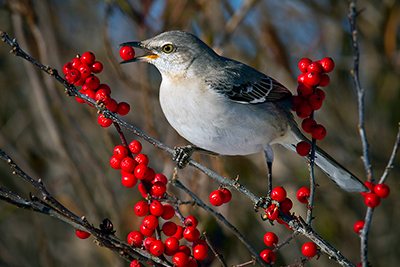
Identification
The official state bird of Florida is a medium-sized bird; it’s got a long tail and is a bit slimmer than a thrush.
Mockingbirds have long, thin bills, long legs, and small heads. Their wings are rounded, wide, and short. This is why the tail looks so long in flight.
Northern Mockingbirds are a grayish-brown color overall. The color gets player on the belly and the breast. Each wing has a white wingbar. A white patch can be seen on the outer tail feathers and on each wing. The wing patches are easily visible when the birds are perched.
Related: The 36 Most common birds of Florida (Based on data)
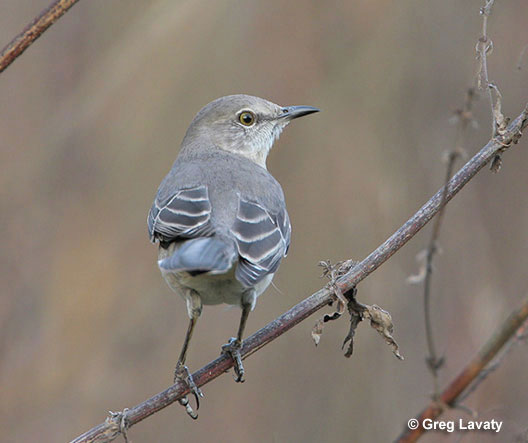
Call
Both sexes of Mockingbirds sing. However, the main thing that Mockingbirds are known for is their mimicking. They’re known for making the songs of other birds and even frogs!
Some of the birds the Northern Mockingbirds are observed to have mimicked are hawks, blackbirds, shrikes, orioles, jays, and killdeer, just to name a few. They can even mimic car alarms.
Their own song is a long sequence of phrases. Each phrase is repeated 2 – 6 times before transitioning to a new sound. On average, songs last around 20 seconds, but they can go on longer.
Many of the phrases Northern Mockingbirds make are whistled, but they also make sharp scolds, trills, and rasps. Unmated male Mockingbirds are the most persistent singers.
Unmated Mockingbirds will carry on singing all day long and into the night. Brown Thrashers have a song that is similar, but the phrases don’t vary as much and are only delivered 2 – 3 times.
Northern Mockingbirds make a dry, harsh chew sound when mobbing predators that attack their nests or when chasing other mockingbirds out of their territory.
Mates exchange a quieter version of this call during the incubation period and the nesting period. Mockingbirds also make a sequence of 2 – 8 scratchy, short chatty calls to warn off intruders.
Related: Hawks in Florida (All 8)
Behavior of Florida State Bird
Northern Mockingbirds can be seen both in pairs and alone throughout the entire year. They’re easily visible because they like to sit atop trees, shrubs, utility lines, poles, and fences to sing.
They can also be seen on the ground hopping, running, and walking with their tails cocked upwards. They grab prey scurrying on the ground, and snatch insects, such as grasshoppers, beetles, and spiders .
Northern Mockingbirds have also been seen flying up and hovering near fruit and berries.
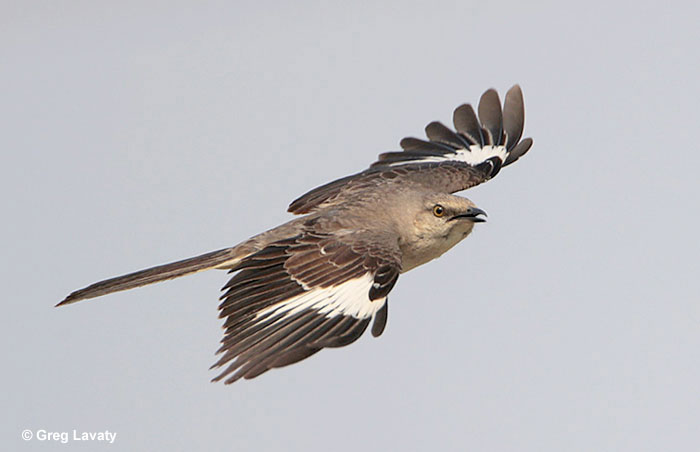
Northern Mockingbird in flight
This songbird is also known to be quite aggressive. This aggressiveness doesn’t go away and sticks around for the year.
Females are known to fend off other females, while males confront males intruding in their territory. Males dispute over territory boundaries by flying at each other, landing near the territory boundary, and facing off. First, they face off by quietly hopping from one side to another.
Eventually, one of the birds will retreat, and the other will chase it for a short time. If neither bird retreats, they’ll fly towards each other, grappling with claws and wings and peck at each other.
Mockingbirds are also known to be territorial around other cats, dogs, and other birds. The flight style of mockingbirds does vary but it’s typically easygoing, with striking wingbeats.
Related: 11 Owls in Florida
People also ask
What is the state bird of Florida?
The state bird of Florida is the Northern Mockingbird.
Why is the Northern Mockingbird the state bird of Florida?
The Northern Mockingbird is the state bird of Florida because it is a common and well-known bird in the state, known for its remarkable singing abilities and varied repertoire. Its melodious songs and graceful presence make it an emblem of the state’s vibrant natural environment.
When did Florida choose its state bird?
Florida chose the Northern Mockingbird as its state bird in 1927.
What other states have the Northern Mockingbird as their state bird?
In addition to Florida, five other states have the Northern Mockingbird as their state bird: Arkansas, Mississippi, Tennessee, Texas, and South Carolina
Read next: Birds of Florida | Hawks in FL | Owls in FL | Woodpeckers in FL | Ducks in FL | Hummingbirds in FL

